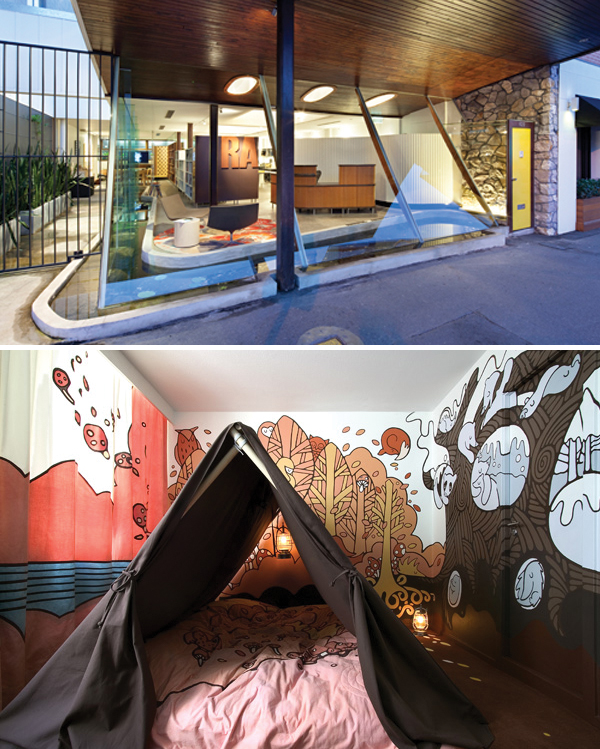A big welcome back to, Katie O’Brien (Interior Designer, BVN Architecture and design writer), who brought us news from the last couple of Bubble and Speak Breakfast seminars from 2010 as guest blogger. This year, Katie will be bringing reports back from DIAlogues, the popular seminar series presented by the Queensland Branch of the Design Institute of Australia (DIA) where design professionals engage, inform and inspire us by getting down and dirty on a range of design issues and hot topics relating to their own practice. Held at Corporate Culture in Fortitude Valley, each seminar features two key design industry speakers and is a great evening in which to catch up with other designers and peers. Read on for Katie’s review, but make yourself comfortable as she covers a lot of ground…
The Design Institute of Australia’s DIAlogues Seminar series launched with a killer opening seminar on 2 March 2011 with two Brisbane boys discussing the very different locales their local work takes them.
With a new upstairs venue at the Corporate Culture showroom and plenty of fresh faces Robert Riddel of Riddel Architecture was first to speak to a sixty-five strong crowd. Discussing the changing face of Brisbane and how we preserve the integrity of this rapidly changing city, Robert spoke of this not only physically in terms of built environments, but culturally as well. It’s about attitudes and Brisbanites need a new one *cough well the BCC mostly cough*. Respect.
Riddel Architecture (RA) is known for its strong focus on contemporary architecture and heritage conservation. In listening to Robert speak, it was obvious that RA are a firm that practices what they preach – their recently completed new office premises at 620 Wickham street is a testament to this, returning the old West’s furniture showroom to it’s original unorthodox state paying homage to designer Karl Langer. Respect.
It is this basic appreciation of Brisbane’s architectural history that Robert spoke of and the crowd was shown a collection of the firm’s most successful works, both new and restored. A long list that had some of Brisbane’s most iconic buildings such as Brisbane’s Customs House and the much loved Spring Hill Baths. It was however the huge amount of projects lost, or competitions simply shelved that had the DIAlogues crowd gasping at what could have been.
Exciting proposals the firm had completed for symbolic Brisbane sites in need of dire respectful intervention, one after the other moved across the projection screen with moans from the crowd as we saw brief glimpses into how the city should look today.
If one of RA’s competition entries were selected, the ratty Howard Smith Wharves should have today been a back packer haven courtesy of the disused 1967’s HMAS Brisbane being used as a floating hotel. Complete with café and cultural precincts, it should have been a tourism dream generating not only income to our city, but a sense of cultural diversity and references to a bygone naval era set amongst the iconic Brisbane cliffs. Instead the proposal was sunk, literally, with the HMAS now a rusty heap of a dive site somewhere in the Pacific Ocean. No respect.
When the firm submitted a DA to the BCC for a two storey addition with garden and photovoltaic’s to one of the firms many Brisbane homes over the years, 7 Diddams Lane, the proposal was considered as an overall design element that utilised the sub tropical environment to enhance the buildings efficiency to give back to the city, instead the BCC viewed this as simply a ‘tack on’ and this commonsense plan was rejected. No respect.
Continuing on to discuss St Johns cathedral and the plan for an eighty story tower proposal that would block river views to the cathedral, Robert discussed the comparisons between river cities such as France, Italy and Brisbane. However noting that the similarities stopped there… “If it was Paris it would be unthinkable to obscure views like that, why not here?” No respect.
Despite the fact that Robert read directly from his notes, his raspy voice was interesting and warm and the patient delivery of his statements combined with the collection of work we were privy to, he kept the crowd’s attention. But you kind of wish he threw the notes away, and went off the cuff with his comments, he has the knowledge of the projects and the experience – just talk about your work and be you Robert!
And that he did, once DIAlogues Q&A time happened. The real Robert came out and the crowd appreciated that the most.
After commenting on the downfalls of the King George Square in his presentation, and many crowd comments as to how it has become an epic fail, when asked to describe the new King George Square in one word, Robert’s response was carefully considered. With the crowd ‘ooohing’ like a bunch of school kids at a pantomime as the question was asked, Robert paused, and everyone waited wide-eyed and mouths agape, wanting a controversial answer yet expecting a PC comment, because Rob is a nice guy and that’s what nice guys do. But when the final response of “________” was delivered, the word resonated with the DIAlogues crowd, as they gasped at the controlled delivery of the statement and the poisonous bite behind it. Yes, it was harsh, but oh so damn true. Aretha Franklin would be proud Robert.
Note: Roberts Riddel’s response cannot be published here as it was promised by the author that he would not be quoted. But please come along next time and I’ll tell you in person what he said.
Adrian Clifford of Design collective Rinzen took to the DIAlogues microphone looking all Johnny Cash, broody and decked out in black. You couldn’t tell if it was nerves, or his general demeanour, but we soon found out he was just a pretty lax dude. It was obvious quite a few people in the crowd had no idea who Rinzen were until the slides started ticking over and it was then that Rinzen’s work became familiar and started to speak for itself.
Adrian gave us an insight as to how Rinzen came to be. It’s began as a group of QCA friends who held “therapy sessions’ where drinking red wine and discussing their dissatisfaction in their post graduate design employment meant that Rinzen was born. Adrian spoke of the benefit of working within a small collective, meaning that in a small studio place, someone is always firing so you can feed off their energy. But the downside to this proximity and standardised wage structure is that you’re always looking to finger point at the slacker amongst the group. No sympathy when you turn up hung over at 9am in the morning. This unbalanced expectation soon resulted in a reshuffling of procedures and approach.
After some time together, opportunities arose for certain members of Rinzen. The company however remained as a whole as a member exited here, a member stayed there and some just purely went over there, to Berlin. In a statement that seems at odds with the age old saying of ‘don’t mix business with pleasure’, Adrian commented that ‘being friends is the key to staying as a whole”. He attributed this to the network of support that Rinzen has developed in their culture over the years and the feedback amongst members that is always honest and forthcoming.
After this great insight into working life, Rinzen’s DNA (all 200 slides and then some) started speeding across the screen. It was great to see the plethora of amazing designs, but we were given only slight glimpses which made you want to yell out ‘stop god damn it!’ so you could take in the intricacies of a particular design or graphic. It surely did whet the appetite.
What we found out was that Rinzen is responsible for some well known Australian advertising campaigns such as Mooks and Commonwealth bank not to mention their international work for Puma, Vogue and DC comics. This was followed by killer band posters and CD art work for local bands such as the Butterfingers or Promotional posters for Fortitude Valley hot spot The Family, not to mention their most iconic work to date – the Hotel Fox interior fit-out in Copenhagen. Adrian said had two of the Rinzen team not relocated to Berlin and formed the branch over there, international high exposure opportunities like Hotel Fox would not come knocking at their door. And despite this scattering of “Geographic locations, the core practice of Rinzen is in traditional design”.
It was the collection of international works sitting alongside locally known pieces that made you realise just how big Rinzen actually is in the world of graphics and how great it is that a large chunk of it is coming out of ‘sleepy’ little Brisbane.
It was an unusual mix of themes that the DIAlogues crowd saw as Adrian presented his take on the creative and business implications of operating in a design collective such as this. On one hand, Rinzen’s work is contemporary, cutting edge, super-sized, bold and eye catching. It’s clean and tidy and schmick. It really does jump from the pages and slap you in the face, in a somewhat delicate manner though. And maybe this is where Adrian’s hand comes into it. He is clearly a very intelligent man. In a climate where designers are often seen as arrogant or self-absorbed surrounded by the faff of themselves, or the faff that others make about them (Karim Rashid anyone?), Adrian was ridiculously well spoken with a timely delivery of his content. Sans notes, he referenced periods of art and design movements that informed certain pieces of work (oh art theory where have thou been?!), speaking about how Rinzen take existing concepts, and reinvent them to appeal to the viewer on another level. Simple as that. You got the impression that Adrian is just a humble, gifted guy that knows his s#it.
So as was done with Robert, when Adrian was asked in one word to describe King George Square, although not as controversial as Robert’s comment, his quick response of ‘Hot’ caused the DIAlogues crowd to laugh in obvious agreeance. But at the risk of sounding like a wealthy hotel heiress known for doing nothing at all, Rinzen’s work is totally hot right now. And I for one have been pimping the Rinzen name to anyone with ears since.
Seminar 02 is attack of the nerds as Hamilton Wilson of Wilson Architecture, and Gretel Bakker of Performance Frontiers talk learning space architecture and neuroscience respectively. Come along to hear them share their love of data collection and research and how this informs their respective fields. See you at the Corporate Culture showroom on Wednesday 6 April 2011, at 6pm.
Thanks for the wrap up Katie, and thanks again to the DIA for arranging these inspirational seminars, to all the speakers and people behind the scenes who make these events possible.
I ashamedly missed this one, but Katie, you’ve got me yearning for the next! See you there!
Images: Top: Riddel Architecture, Bottom: Hotel Fox room by Rinzen


